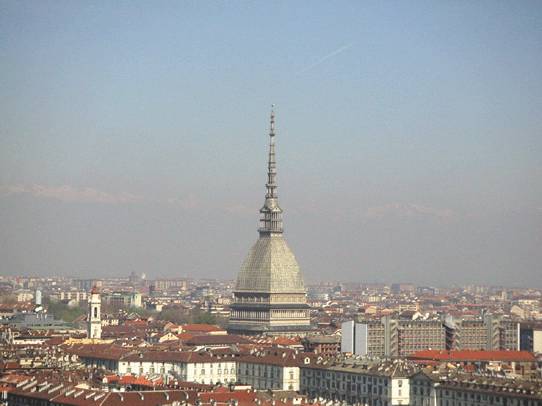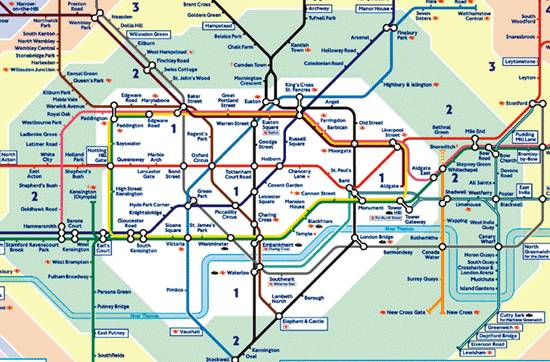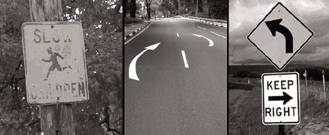Section 2.4. The Built Environment
2.4. The Built EnvironmentIn his 1960 book, The Image of the City, Kevin Lynch inspired a generation of architects, planners, designers, and citizens to envision urban spaces as a functioning whole. Using the concept of environmental legibility, he focused attention on the structure and organization of a city's wayfinding systems. Drawing upon extensive studies conducted in Boston, Jersey City, and Los Angeles, Lynch brought to life the orientation and navigation experiences of real people in real cities. He contrasted the anxiety and even terror caused by disorientation with the sense of balance and well-being produced by the easily recognizable patterns of a legible city. And he created a vocabulary for describing a city's elements that laid the foundation for modern wayfinding design.
People construct an environmental image of the city, composed of these building blocks, that provides context and supports wayfinding. In the shadow of the Eiffel Tower, the straight path of the Avenue des Champs Elysées, shown in Figure 2-5, connects the landmarks of the Arc de Triomphe and the Louvre, creating one of many powerful combinations that makes Paris a legible city. In contrast, Boston's winding streets and dearth of high-visibility landmarks (not to mention the perpetual construction project known as the Big Dig) combine to disorient travelers, making them need maps like that in Figure 2-6. As Lynch's title suggests, the impact of legibility goes beyond wayfinding; it shapes people's image of the city. Getting lost in a city can be frustrating and scary. Frequent negative experiences hurt the city's brand. In contrast, landmarks that combine form and function by serving as beautiful wayfinding tools can greatly enhance the city's image. San Francisco's Golden Gate Bridge (Figure 2-7) and Turin's Mole Antonelliana (Figure 2-8) are just a couple of widely admired examples. Figure 2-5. Avenue des Champs Elysées in Paris Following in the footsteps of Kevin Lynch, designer Paul Arthur and architect Romedi Passini advanced our understanding of the built environment in their 1992 book, Wayfinding: People, Signs, and Architecture. In this landmark text, the authors make the economic and ethical case for the importance of wayfinding design:
Arthur and Passini remind us that poor wayfinding design (see Figure 2-9) doesn't just lead to frustration, wasted time, and missed connections in airports and train stations. People die because ambulance drivers can't find their way to an address in time. People die because of badly placed or poorly labeled fire exits. People die because they're looking at a map instead of the road. Because of poor wayfinding design, people die. And the significant (and growing) numbers of people with disabilities from those with limited vision to those suffering from Alzheimer's face greater wayfinding challenges and risks than most. Figure 2-7. San Francisco's Golden Gate Bridge serves as path, landmark, node, and edge Having illustrated the problems of wayfinding, the authors explain how architects, urban planners, graphic designers, and building managers can create solutions:
It's interesting to consider the applicability of these recommendations to online information systems. The lessons from the built environment fit nicely with the exhortations of web usability experts such as Jakob Nielsen and Steve Krug. Users don't read, they scan. Break up pages into clearly defined areas. Provide multiple navigational paths. Keep it simple. Don't make me think! Figure 2-8. La Mole Antonelliana is a landmark in the heart of Turin; as a museum for the history of cinema, it's also a favored destination Figure 2-9. All of us have been confused by signage Of course, there are fundamental differences between physical and digital realms, and we'll get to those soon. But for now, let's conclude our focus on the built environment by acknowledging a theme that courses through the literature of wayfinding and usability alike: the vital importance of empathy for the user. Only by understanding and caring about the perspective of the individual can we design useful, usable solutions. Only by designing for emergent patterns of use that flow from common needs, desires, instincts, and behaviors can we create shared spaces that unite form and function. As the architect Christopher Alexander asserts:
From the hunter-gatherers of the African Savannah to the commuters of New York and Los Angeles to the searchers of Yahoo! and Google, humans have drawn upon an inherited set of senses and skills to navigate dissimilar environments. Our surroundings change, but the wheels of evolution turn slow. As the information age propels us faster and deeper into cyberspace, an appreciation for the history of wayfinding behavior in natural and built environments will prove quite handy. |
EAN: 2147483647
Pages: 87
